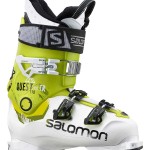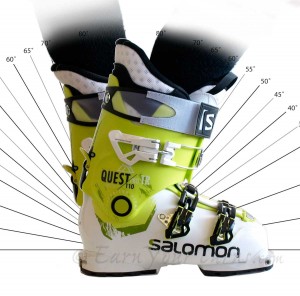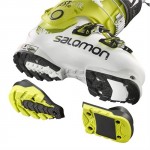Touring
Unlike the majority of Salomon’s AT boots the Quest TR series will keep you smiling on the skin track, thanks to tech fittings on the toe and heel blocks. If you insist you can swap those out for alpine DIN sole blocks, but why bother? With all the choices in 2-pin bindings these days, less weight doesn’t necessarily mean less downhill performance.
Within Salomon’s backcountry boot offerings the Quest Pro TR 110 is the lightest, and arguable best touring boot of the bunch. It is the only Salomon AT boot that weighs less than four pounds per foot (mondo sz. 26.5). It doesn’t set any records for light weight, but it’s a good compromise for working as well under the lifts as away.
Like the weight, cuff ROM doesn’t set any records, but allows a respectable 17° back and 30° forward. Compared to many boots on the market, the lack of resistance to cuff movement is less than average, making them easier to walk in than many AT boots. If there are any complaints to touring mode it is the lack of a touring tooth on the cuff buckle. You can certainly get more forward range of motion if you open up the cuff buckle, but it is bound to fall off the ladder and flop around. I’m not a big fan of resetting in a touring tooth, but it would be better than none.Fit
Provided you aren’t obsessing about how much vertical you climb, or winning any races, perhaps the average tourability and downhill performance can be excused for an out of box comfort that has few equals in the ski boot world. It has a roomy last of 100mm, but felt equally snug as many boots with a narrower last. A portion of that comes from a liner with well molded ankle cups to capture your foot and hold it in the heel pocket. This keeps your forefoot from sliding forward, leaving plenty of wiggle room for your toes, for all day comfort. Should you need more customization, the liner is heat moldable.
Downhill Chops
In the downhill department a 110 flex sounds a bit soft but it felt slightly stiffer than the Scarpa Freedom SL, and a bit less progressive owing to a fairly upright forward lean angle. Thus, with a modicum of driving force the Quest Pro TR had no issues controlling skis in rough and variable conditions. Buckle counters will lament there are only three buckles, but the power strap is 50mm wide, so it provides a secure link to your lower leg.Conclusion
As with most boots in the mid-weight AT category, the Quest Pro TR is a good free ride boot where you plan on exercising your right to freely ride anywhere on the mountain, in- or out-of-bounds. There are certainly lighter boots, stiffer boots, boots with more touring mobility, and more expensive boots. If you’re new to earning your turns, or you get less than 20 days on snow a year, this is a great boot that will make your backcountry forays easy to enjoy without sacrificing in-bounds performance.
Salomon
Quest Pro TR 110
MSRP: $750
Weight/boot (26.5): 1763 g | 3 lbs., 15 oz.
Sizes available: 24.5–30.5
© 2014




Recent Comments